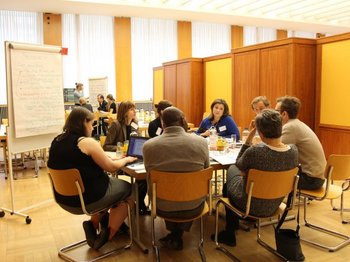The title, a phrase attributed to Winston Churchill, illustrates some of the challenges and difficulties of the debate around working together in emergency and humanitarian responses. This is the theme for ALNAP’s 30th Annual Meeting which I have been organising in the past few months.
So what is it that we need to know about coordination at country level? To introduce what more than 200 participants from all over the globe are going to debate at our Annual Meeting, I imagined a dialogue between a cluster representative (Ms. U) and INGO worker (Ms. N) and a national NGO director (Mr. Z).
Ms. U: For effective humanitarian coordination you need order, structure and long-term vision. You need information exchange, clear roles and responsibilities, protocols and procedures and definitively a director! It is not only a good idea but a necessity in the context of a growing humanitarian case load and the increasing number of actors involved. Unless we coordinate more and better, we are not going to be able to respond effectively to the expanding humanitarian needs. It is not only about responding to emergencies, but also about preparation, you see?
Ms. N: Yes I agree, coordination is needed; for coverage, both geographical and sectoral, and to avoid gaps and duplication. My problem is that I have been asked to focus on saving lives now, not think of public policies.
What you say is great in an ideal world but in the complex reality of emergency response, we need to be clear on our priorities. Moreover, coordination is a process that has costs! Who decides which of our priorities gets dropped in exchange for more resources and time allocated to coordination efforts? What information needs to be exchanged? Emergency staff want clear and brief information about what they need to know, not what would be nice to know… You see? It’s not black and white…
Mr. Z: This is all very interesting, but who decides who is the director? Who gets hired and who gets excluded from emergency management? Last year in my country a massive disaster took place, despite the structures and capacities that existed, it was still very much the case that international organisations did not even talk to us! I heard that out of 29 HCTs (Humanitarian Country Teams) only one has a representative from the affected government! Is this really what you call coordination?!

Photo credit: ALNAP
Ms. U & Ms. N: Oh yes, national actors and southern NGOs are too often excluded from coordination. This certainly needs to change.
Ms. U: The affected state has the primary responsibility to coordinate emergency and relief efforts! UN resolution 46/182 adopted almost 25 years ago to this day, provides an ample normative framework that supports this. In practice many governments have set up specialised administrations or bodies, the rise of national disaster management authorities (NDMAs) is a reality in many parts of the world… With the projected growth of humanitarian needs, we cannot afford to ignore what is available locally. The state has to be the director!
Ms. N: Although in other parts of the world, complex emergencies in situations of armed conflict present clear risk to humanitarian principles and access to affected communities… Aid should not be submitted to political agendas.
Mr. Z: Yes please, not all national and local actors are the same, neither are the contexts in which humanitarian responses take place!
Ms. N: Yes, we cannot continue to apply the one size fits all approach to emergency response. I like the models proposed by ALNAP, the reality is that not all governments have the same capacities… or willingness…
Mr. Z: Well ALNAP’s 30th Annual Meeting in Berlin will illustrate this brilliantly. More than 25% of the panellists are from crisis affected places as diverse as the Philippines, Sierra Leone, Jordan, Ethiopia, Myanmar, Syria, Burundi, Afghanistan and Palestine. Participants will share their experiences and learning around coordination. That should stop you talking about southern organisations, we are active and diverse!
Ms. U: I am looking forward to it, several panels will analyse results of formal coordination structures and different modalities for working together from bilateral (partnerships) to multilateral (networks and coalitions) and how technical and thematic areas such as cash and advocacy challenge the way we coordinate.
Mr. Z: These ALNAP people are looking for an honest and open debate over what coordination means at country level, their discussion paper has just been released. It includes a taxonomy of humanitarian coordination – defining different levels of coordination.
Ms. U: And Z, as informal arrangements and access to resources are paramount for appropriate coordination, let me invite you two to the café so we can discuss the participants and guests of the upcoming ALNAP Annual Meeting in Berlin!
For more details about ALNAP’s Annual Meeting, which this year is hosted by the German Federal Foreign Office in Berlin, please check visit our 30th Annual Meeting page. An updated agenda, discussion starter and additional information can be found here. As per usual, all interventions will be available on the ALNAP website after the meeting for open consultation.
For more information on previous ALNAP Annual Meetings please visit our Annual Meetings page.